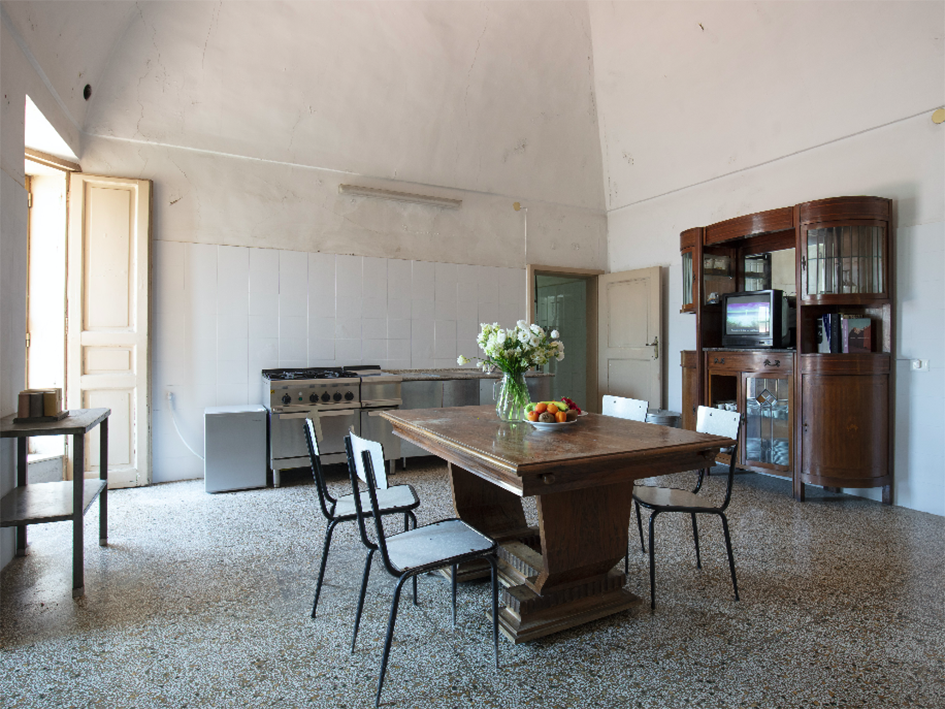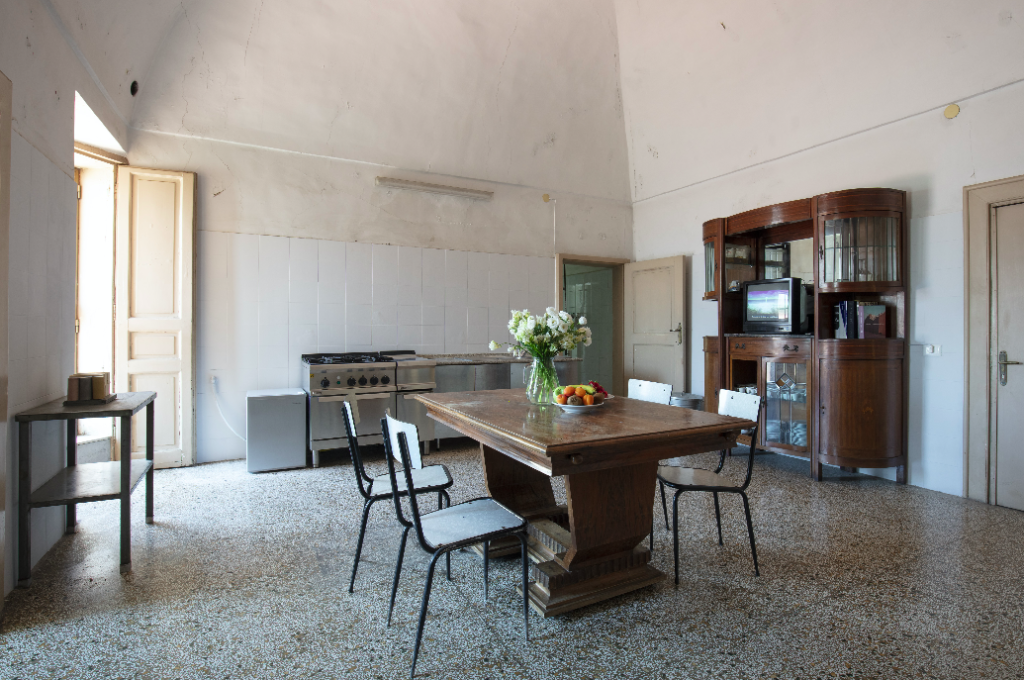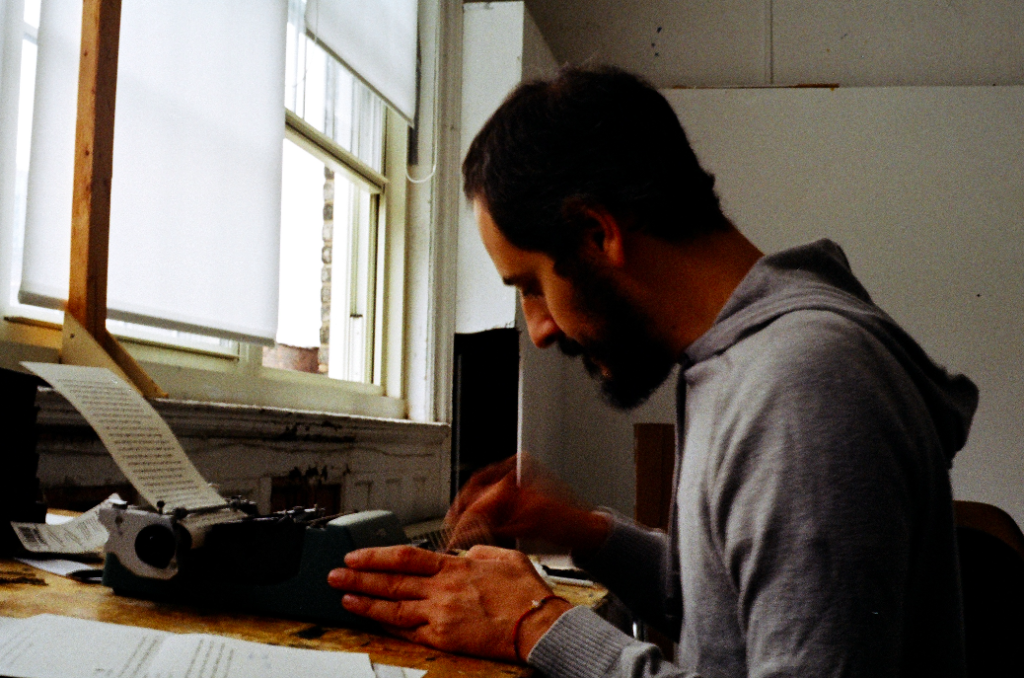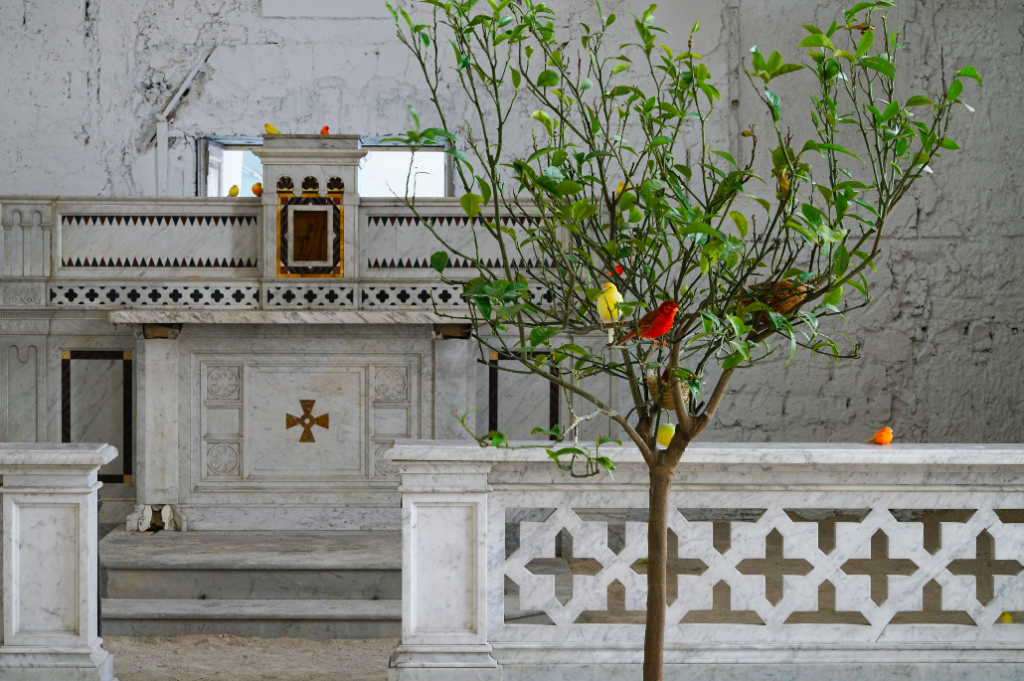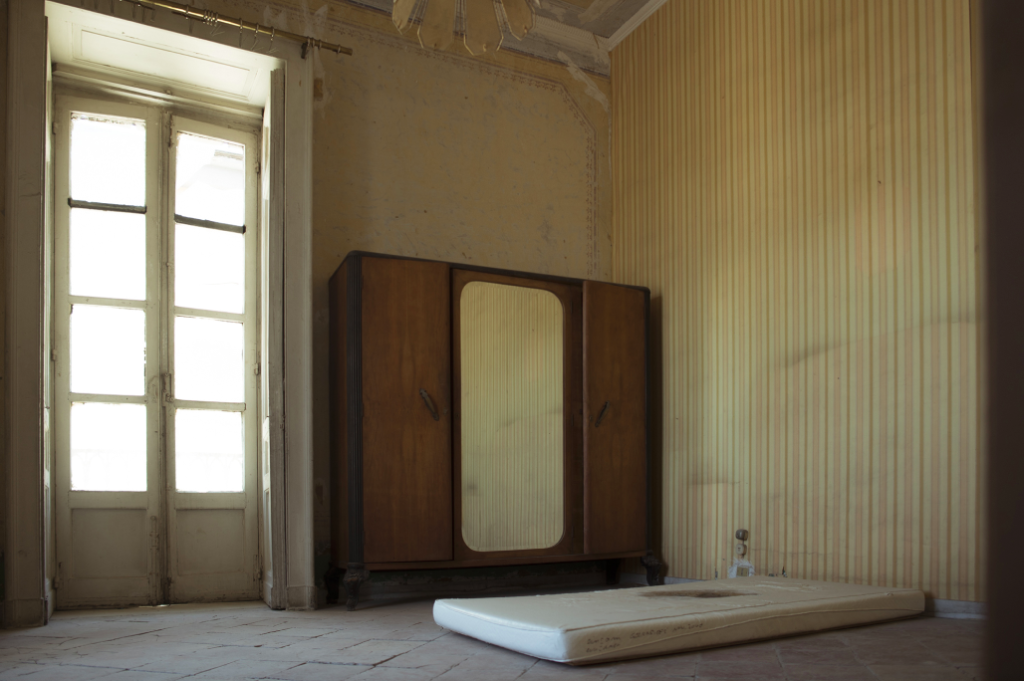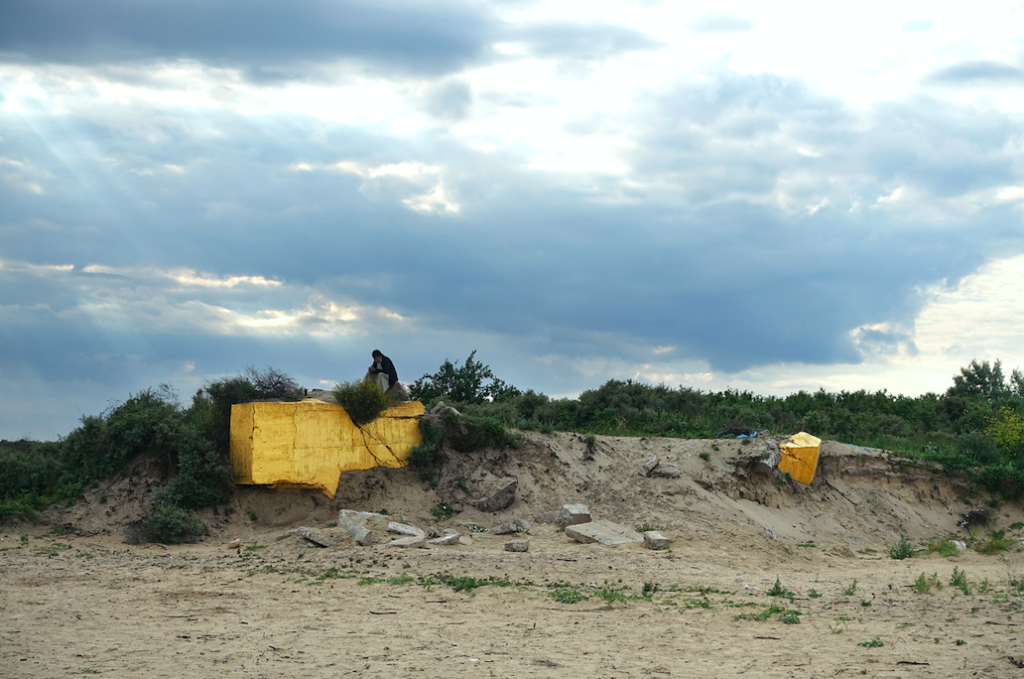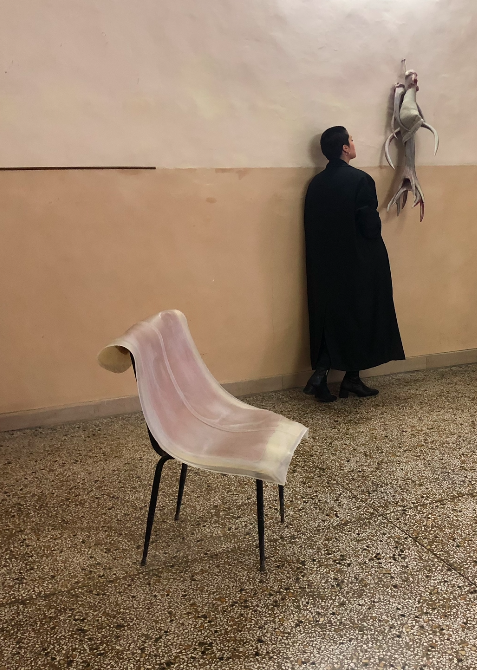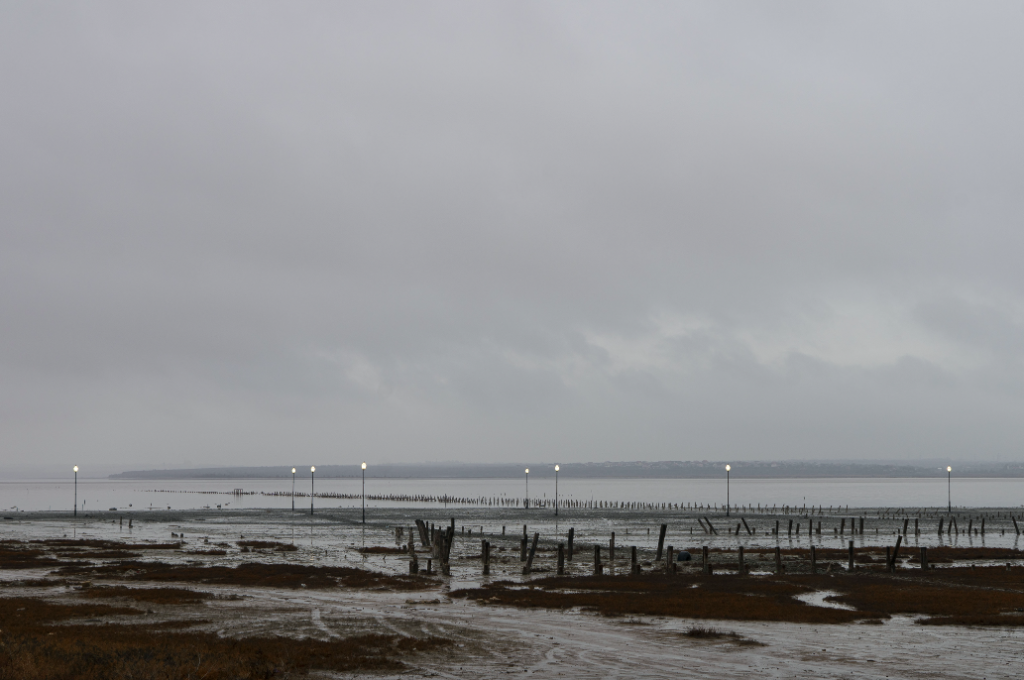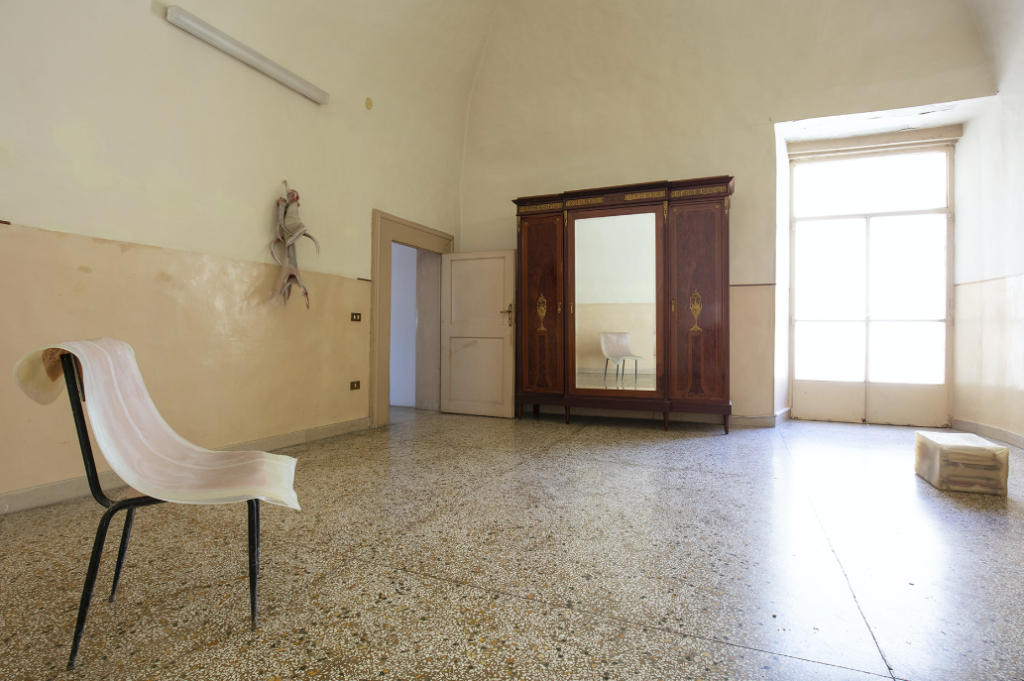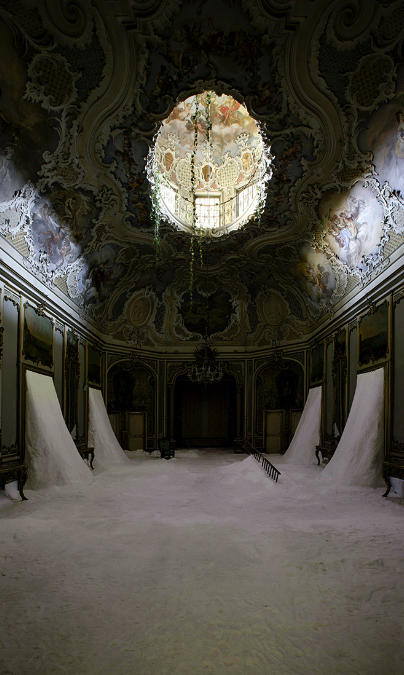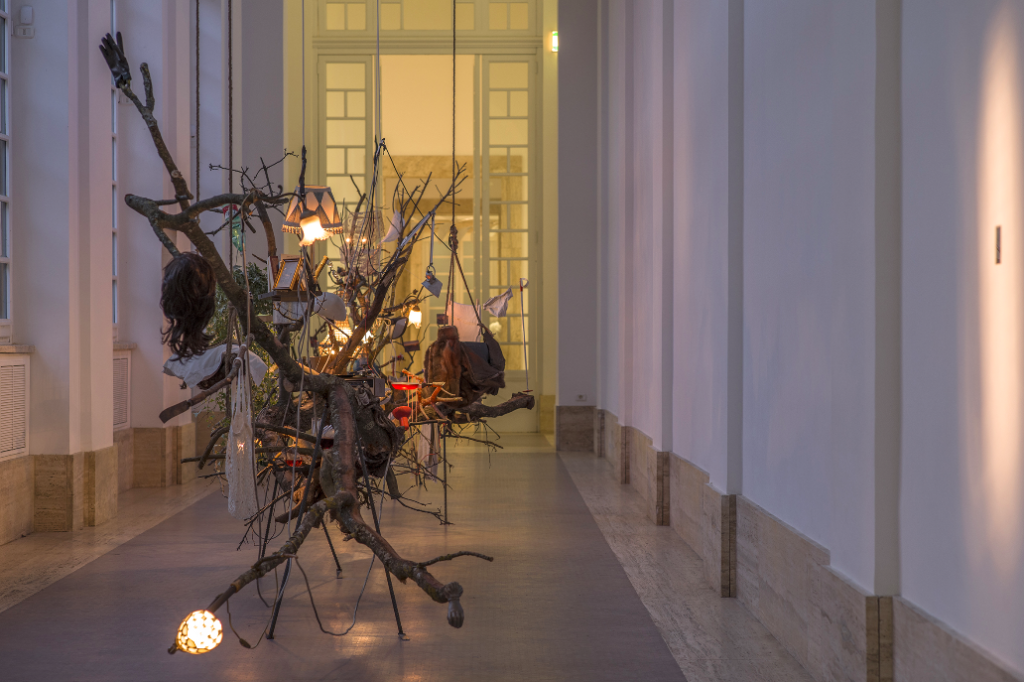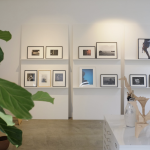“Un momento di pausa”
Conversazione familiare
Gian Maria Tosatti / Lucrezia Longobardi
__
Confinis
progetto a cura di Marco Tagliafierro
__
La conversazione intercorsa tra Gian Maria Tosatti e Lucrezia Longobardi
è una conversazione famigliare che riscopre riverberazioni e risonanze
proprio sul crinale delle loro rispettive vite:
sincroniche, parallele, eppure osmotiche.
GMT – In quasi otto anni, penso che questa sia la prima volta che facciamo una conversazione pubblica. Alla fine, abbiamo provato a non lavorare mai insieme e abbiamo dedicato i momenti di confronto alle ore serali, negli spazi della cena, o delle discussioni più rilassate. A volte, in casa, vengono persone per te, altre per me. Sempre più spesso sono le stesse persone. Con intenti diversi, altre modalità di dialogo. Ma, nel tempo, anche a prescindere delle nostre profonde differenze e dei nostri caratteri difficilissimi, abbiamo finito per convergere sulle idee, sugli orientamenti legati all’arte italiana. Abbiamo finito, con percorsi autonomi e indipendenti, a legarci alle stesse persone, ad avere, per vie quasi del tutto separate, gli stessi compagni di strada. Penso sia piuttosto affascinante questo trovarsi anche quando non ci stiamo cercando. Questo gravitare delle nostre menti attorno agli stessi poli.
Penso sia piuttosto affascinante questo trovarsi anche quando non ci stiamo cercando.
Questo gravitare delle nostre menti attorno agli stessi poli.
Ogni tanto penso alle coppie di intellettuali, nella storia dell’arte, della letteratura…
LL – Quello che dici mi ha fatto subito tornare alla mente l’ultimo passaggio del film Controracconto, il documentario su Sette Stagioni dello Spirito, facendomi riflettere su come, alla fin fine, di conversazioni pubbliche ne abbiamo avute. Magari non erano momenti ufficiali, ma tra me e te questa differenza conta poco. Riguardo alle coppie a cui ti riferisci, suppongo, e lo faccio per esperienza diretta, che il rapporto di intimità, stima reciproca e umana comprensione siano alla base di ogni scambio intellettuale; la differenza tra una relazione passionale ed una relazione amicale credo stia nella maggiore generosità del darsi.
- Lucrezia Longobardi (a cura di), Lo spazio esistenziale. Definizione #2, Casa Morra - Napoli 2019, installation view (nell’immagine: Rachel Whiteread, Colours, 2008 - Roberto Cuoghi, Foolish Things, 2002). Ph: Amedeo Benestante
Qualche anno fa ho letto tutto d’un fiato l’epistolario tra Hannah Arendt e Martin Heidegger ed ho osservato per la prima volta, dall’esterno, cosa siamo e come viviamo. Nelle maglie della conversazione tra i due filosofi traspare la profondità della riflessione sul circostante, intrecciata con gli elementi della loro relazione, fino a dar vita ad una sovrapposizione suggestiva tra il piano del sentimento e quello del pensiero filosofico. Un passaggio, nelle prime lettere scritte da Heidegger mi colpì molto. Te lo riporto.
Cara Hannah!
Perché l’amore è ricco oltre ogni misura rispetto alle altre umane possibilità e risulta per chi ne è coinvolto un peso così dolce? Perché noi ci trasformiamo in ciò che amiamo pur rimanendo noi stessi. Vorremmo poi ringraziare colui che amiamo e non troviamo niente che sia sufficiente per farlo.
Possiamo soltanto essere riconoscenti nei confronti di noi stessi.
L’amore trasforma la gratitudine nella fedeltà verso nei stessi e nella fiducia incondizionata verso l’altro. Così l’amore accresce costantemente il suo mistero più profondo.
La vicinanza è in questo caso l’essere alla massima distanza dall’altro – una distanza, che non porta a confondere nulla – ma pone il «Tu» nel trasparente – ma inafferrabile – puro e semplice essere-qui di una rivelazione. L’irrompere della presenza dell’altro nella nostra vita è qualcosa che nessun sentimento riesce a dominare.
Un destino umano si dà a un altro, e la funzione dell’amore puro è quella di mantenere desto questo darsi come il primo giorno.
Ecco, questa, come la nostra, oltre ad essere una relazione tra pensatori è stata in primo luogo una relazione tra amanti, in cui l’insieme dei vissuti empirici ha marchiato anche le rispettive ricerche filosofiche, seppur lontanissime, anzi quasi opposte.
Ciò che, invece, a me preme sempre sapere, ciò che mi incute anche un certo timore – forse perché come la Arendt sono più giovane del mio amante – è quanta contaminazione ci sia dell’uno nell’altro, dove – o quando – le mie idee germogliano grazie al confronto, divenendo altro e viceversa.
Come uno scambio così profondo possa permettere all’individuo di preservare l’individualità soggettiva?
Il filosofo tedesco nelle righe che ho citato affronta anche questo, ma vorrei sentirmi dire da te cosa accade.
GMT – Tocchi un punto inaspettato. Credevo avremmo portato questo discorso più sui valori che sulle pratiche. Ma ti rispondo volentieri. Sì, il mio lavoro è stato profondamente influenzato dalla tua presenza in questi anni. L’attitudine al dialogo, al confronto, serrato, a volte acuminato, che dal tavolo della nostra cucina si sposta a quello del salotto, alla scrivania del tuo studio, alla nostra libreria, costantemente ridotta come un letto sfatto, mi ha portato verso la necessità di un argomentare più teorico. Vivere con un critico, ha necessariamente posto delle condizioni al mio linguaggio. Come artista, forse le opere continuano ad essere autonome, ma non posso non pensare che il nuovo libro che sto scrivendo, e che, nei fatti, è un trattato di estetica, non sia il prodotto di un’attitudine che è maturata attraverso le nostre continue discussioni sul concetto di esperienza, di display, di visione, di rapporto opera-spettatore.
Come artista, forse le opere continuano ad essere autonome, ma non posso non pensare che il nuovo libro che sto scrivendo, e che, nei fatti, è un trattato di estetica,
non sia il prodotto di un’attitudine che è maturata attraverso le nostre continue discussioni
sul concetto di esperienza, di display, di visione, di rapporto opera-spettatore.
La tua presenza, nelle ore in cui riusciamo ad incontrarci, pone costantemente problemi di metodo al mio lavoro. E dalla necessità di trovare risposte nasce anche una pratica alternativa, che è quella dell’attività teoretica.
Su questo non fraintendere. Ho sempre scritto molto. Come editorialista, come diarista. Ma in questi ultimi anni, in cui il tuo ruolo si è fatto più chiaro e preciso, anche la mia scrittura ha cambiato prospettiva. E’ passata da un orizzonte più autorale, ad uno più tecnico. Questo perché il dialogo con te insiste sempre su elementi analitici.
- Gian Maria Tosatti al lavoro nello studio di New York, 2017 - foto scattata da Lucrezia Longobardi
Però, mi sono chiesto anche tante volte, quanto il tuo lavoro di curatore, così tanto dedicato al concetto di spazio e di performance si siano nutriti del portato delle esperienze che ho potuto condividere. Sono consapevole che, in realtà, il tuo percorso di ricerca sia così profondamente intimo e personale da non poter davvero essere attribuito ad ispirazioni esterne (ne ritrovo stralci, frammenti, fin dalle tue fotografie dell’adolescenza). Ma è certamente sorprendente la coincidenza che ha portato quella che ho conosciuto quando era ancora una studentessa di incisione a diventare un critico con una ricerca tanto fortemente radicata al concetto di spazio, negli anni che abbiamo passato insieme tra Napoli e New York.
LL – Non so dove bisognava portare questo discorso; io ti rispondo, come sempre, secondo le mie linee e i miei bisogni.
La domanda posta sull’individualità soggettiva era più rivolta alla mia ricerca che alla tua, ma hai ragione quando affermi che ci sono sempre stati stralci del mio ossessivo interesse per lo spazio nei miei esercizi di comprensione del mondo. Nelle mie fotografie, nei miei disegni, ritornavano elementi che a me non erano chiari e che soltanto tu sei riuscito a rendermi familiari.
Nelle mie fotografie, nei miei disegni, ritornavano elementi che a me non erano chiari
e che soltanto tu sei riuscito a rendermi familiari.
Ecco, in questo c’è stato un altro passaggio importante del nostro rapporto, la lettura della mia ricerca.
La tua lettura dei miei primi materiali è stata rivelatoria per me anni fa, mi ha permesso di organizzare in un discorso compiuto le mie teorie ed è diventata poi una metodologia che ho imparato ad usare per poter osservare, ed entrare, nelle ricerche degli artisti.
Per cui torniamo al punto di partenza.
Dov’è davvero lo scarto tra due pensatori che si cercano e si frequentano, quali sono le differenze che a noi non appaiono più, assimilate da una contaminazione ormai inestricabile?
GMT – Ho sempre avuto una certa difficoltà col tema della singolarità. Fin da quando andavo a scuola. Vedevo la differenza tra la società giapponese, permeata dal senso di comunità, di gruppo, e la nostra, occidentale, marcatamente individualista. E mi rendevo conto che c’era un errore di impostazione in noi, uno di quelli che fanno saltare tutto il sistema. E’ nella singolarità, nella gelosia di se stessi, il punto debole dell’occidente. E vale in ogni ambito. L’individualità è un punto morto dell’essere. E’ l’essere nel silenzio.
E’ nella singolarità, nella gelosia di se stessi, il punto debole dell’occidente. E vale in ogni ambito. L’individualità è un punto morto dell’essere. E’ l’essere nel silenzio.
Non ho mai considerato gli intellettuali del passato, come delle monadi. Studiando la storia delle arti, delle scienze, ti rendi conto che tutto è frutto di un dialogo corale. Dunque, anche tra me e te che senso avrebbe fare distinzioni? Nella storia dell’arte non ci sono quasi mai artisti soli. Anche le avanguardie del secolo scorso – il fenomeno più recente prima del declino – erano sistemi di menti in connessione. Poi quella temperatura di fusione, quell’appartenersi di pensieri e gesti è andato scemando. Ci sono state neo-avanguardie, come l’Arte Povera, e trans-avanguardie, in cui s’è passati dal dialogo all’orchestrazione. E i risultati hanno iniziato ad essere molto più deboli. Fino, appunto, al presente, in cui, invece di cercarci, definiamo con attenzione i confini precisi tra noi e gli altri. Per evitare ogni contaminazione, ogni infezione. Ma l’arte, come la vita, è una febbre. Bisogna passarsela. Quando si è sani, isolati, chiusi dentro il proprio perimetro di pelle, si muore. Allora, ecco, non lo so quale sia davvero il limite tra i nostri pensieri. So riconoscere le correnti, quelle che vengono da te o quelle che vengono da me, ma non saprei dirti in che punto si dividano gli oceani. E così dev’essere. Dovremmo allenarci ad essere così anche con gli altri. A volte ci riusciamo. Alla cena per la tua mostra alla Galleria Nazionale c’erano una ventina di persone: artisti, critici, filosofi… Quella sera mi sembrava che fossimo tutti molto più che “professionisti”. In una trattoria romana, sembravamo tutti parte di una famiglia intellettuale. Come nella Roma delle avanguardie di un secolo prima. E’ stata la serata più bella della mia vita.
- Gian Maria Tosatti, 7_Terra dell’ultimo cielo, 2016
Ecco, lo vedi? La mia serata migliore è stata quella di una tua mostra. Non di una mia.
Piuttosto, dimmi. Che cos’è stato per te, in tutti questi anni, imparare a scalare l’anima degli artisti con cui hai lavorato?
Non hai mai avuto l’approccio compilativo da storico dell’arte. Hai preso spesso le loro opere e le hai trasformate, usate, come strumenti di caccia, di sopravvivenza. All’inizio, mi ricordo, avevi paura di farlo. Almeno a parole esitavi (anche se coi fatti, poi, tiravi dritto). E mi ricordo una volta a Londra come ti guardava Zoe Leonard quando le dicevi che cosa avresti voluto fare con una delle sue opere più delicate e significative. E alla fine ti disse che ti avrebbe aiutata in ogni modo ad avere l’opera in prestito per poterlo fare. Fu, poi, il museo che si oppose con tutte le sue forze, ma come scrisse Viliani in un suo testo, il fantasma di quell’opera era presente in quella mostra quasi più delle opere che c’erano veramente. Anche questo ha molto a che fare con la fusione, non trovi? Questo lasciarti indossare le loro opere da parte degli artisti; questa voglia che gli fai venire di smontarle dall’attaccapanni del museo e farle tornare plasmabili, com’erano quando ancora stavano tra le loro mani, prima di essere forgiate.
LL – Quello che dici è vero. Il mio approccio critico diretto ed empatico, è qualcosa di così naturale che credo non avrei mai potuto combattere, anche volendo.
Ci ho provato.
Durante i miei primi lavori curatoriali, mi sentivo sfacciata ad appropriarmi dei lavori degli artisti, declinandoli e piegandoli alle mie verità, alla mie esperienze. Ho cercato di darmi una disciplina e imitare i colleghi più grandi di me. Questa metodologia distaccata e accademica era però mortificante rispetto alla visione totale che avevo della mia idea di mostra. In realtà, più cercavo di “fare le cose giuste” e più ingessavo i miei movimenti, rendendo anonimo il mio lavoro.
In realtà, più cercavo di “fare le cose giuste” e più ingessavo i miei movimenti,
rendendo anonimo il mio lavoro.
Quando poi, alle prime lunghe lettere inviate agli artisti con i quali volevo lavorare, ho cominciato ad avere risposte positive ed esaltanti, è stato chiaro che potevo mantenere il mio passo. Un passo che cammina di fianco all’artista, ma si pone in modo autorale e non solo compilativo o allestitivo, problematizzando le opere e sì, in maniera sfrontata e a tratti irriverente, piegandole alla mia narrazione; facendo un lavoro di cucitura tra l’esperienza dell’artista e quella del curatore, tra il portato concettuale o gestuale e quello filosofico; fondendo due ricerche. Lo studio sperimentale che sto portando avanti attraverso un lavoro completamente umano e viscerale, biologico, è la chiave con la quale, come dici, forse sto scalando l’anima degli artisti, arrivando al midollo delle loro opere e ricalibrandole poi sulle mie ossa, sulla mia misura. Ma tutto questo è solo per portare l’estasi nella percezione dello spettatore.
- Lucrezia Longobardi (a cura di), Lo spazio esistenziale. Definizione #1, Fondazione Morra 2017, installation view (nell’immagine: Gregor Schneider, Einsam - Einsam, 2000). Ph: Elio Di Pace
“Taking a break.”
Family conversation between
Gian Maria Tosatti and Lucrezia Longobardi
GMT – In nearly eight years, I think this is the first time we’ve had a public conversation. In the end, we’ve tried never to work together and we’ve confined our discussions to the evening hours, in the time around dinner, or more relaxed conversations. Sometimes people come to the house for you, sometimes for me. More and more often they are the same people. With different intentions, other forms of dialogue. But, over time, regardless of our profound differences and our very difficult characters, we have ended up converging on our ideas, on our leanings related to Italian art. We’ve ended up, with autonomous and independent paths, linking ourselves to the same people; we have, in almost completely separate ways, the same travelling companions. I think its quite fascinating to find ourselves even when we’re not looking for each other. This gravitating of our minds around the same poles. Every now and then I think of intellectual couples in the history of art and literature…
I think its quite fascinating to find ourselves even when we’re not looking for each other.
This gravitating of our minds around the same poles.
LL – What you say immediately reminded me of the last passage of the film Controracconto, the documentary on Seven Seasons of the Spirit, making me reflect on how, in the end, we have had public conversations. Maybe they were not at official events, but between you and me this difference counts for little. With regard to the couples you refer to, I suppose, and I do it from direct experience that the relationship of intimacy, mutual respect and human understanding are the basis of any intellectual exchange; the difference between a passionate relationship and a friendship relationship, I believe, is the greater generosity of giving oneself.
- Gian Maria Tosatti, Histoire et Destin - New Men’s Land (Star), 2016
A few years ago I read in one sitting the correspondence between Hannah Arendt and Martin Heidegger and I observed for the first time, from the outside, what we are and how we live. The depth of their reflections on their surroundings, intertwined with the elements of their relationship, shines through the meshes of the conversation between the two philosophers, to the point of creating a striking overlap between the level of feeling and that of philosophical thought. One passage in the first letters written by Heidegger struck me a lot. I’ll read it to you.
Dear Hannah!
Why is love rich beyond all measure compared to other human possibilities and does it result in such a sweet burden for those involved? Because we become what we love while remaining ourselves. Then we would like to thank the one we love and we find nothing adequate to do so.
We can only be grateful to ourselves.
Love transforms gratitude into fidelity towards oneself and unconditional trust towards the other. Thus love constantly increases its deepest mystery.
In this case, closeness is being at the maximum distance from the other – a distance, which does not lead to anything confusing – but it makes “You” in the most intimate sense transparent – but elusive – a pure and simple being – here a revelation. The eruption of the presence of the other in our life is something that no feeling is able to dominate. One human destiny gives itself to another, and the function of pure love is to keep this giving as alive as it was on the first day.
Here, this, like ours, in addition to being a relationship between thinkers, was first and foremost a relationship between lovers, in which the set of empirical experiences also marked their respective philosophical studies, albeit very far apart, indeed almost opposite.
What, on the other hand, I always want to know, what also arouses me a certain fear – perhaps because like Arendt I am younger than my lover – is how much cross-fertilization there is from one to the other, where – or when – my ideas germinate thanks to comparison, becoming something else and vice versa.
- Her, Lucrezia Longobardi durante l’installazione della sua mostra Lo spazio esistenziale. Definizioni #2 - foto scattata e intitolata da Gian Maria Tosatti
How can such a profound exchange allow the individual to preserve subjective individuality?
The German philosopher in the lines I quoted also addresses this, but I would like to hear from you what happens.
GMT – You touch on an unexpected point. I thought we would carry this discourse more on values than on practices. But I’ll gladly answer you. Yes, my work has been deeply influenced by your presence over the years. The aptitude for dialogue, confrontation, close, sometimes sharp, that moves from our kitchen table to the living room, to the desk in your study, to our bookcase, constantly rumpled like an unmade bed, led me to the need for a more theoretical argument. Living with a critic has necessarily placed conditions on my language. As an artist, maybe the works continue to be independent, but I can’t help thinking that the new book I’m writing, which is a treatise on aesthetics, cannot but be the product of an attitude that has matured through our continuous discussions on the concept of experience, of display, of vision, of the work-viewer relationship. Your presence, in the times when we manage to meet, constantly poses methodological problems to my work. And from the need to find answers, practical alternative also arises, which is that of theoretical activity.
As an artist, maybe the works continue to be independent, but I can’t help thinking that the new book I’m writing, which is a treatise on aesthetics, cannot but be the product of an attitude that has matured through our continuous discussions on the concept of experience, of display, of vision, of the work-viewer relationship.
Don’t misunderstand this. I’ve always written a lot. As a columnist, as a diarist. But in recent years, during which your role has become clearer and more precise, my writing has also changed perspective. Its gone from a more authorial horizon to a more technical one. This is because the conversation with you always insists on analytical elements.
- Gian Maria Tosatti, Моє серце порожнє, як дзеркало - Одеський епізод, 2020
However, I’ve also wondered many times, how much your work as a curator, so dedicated to the concept of space and performance, was fed by the experiences that I was able to share. I’m aware that, in reality, your investigative path is so deeply intimate and personal that it can’t really be attributed to external inspirations (I can discover excerpts, fragments, right from your adolescent photographs). But it is certainly a surprising coincidence that led the person I met when she was still a student of engraving to become a critic whose area of interest is so strongly rooted in the concept of space, in the years we spent together between Naples and New York.
LL – I have no idea where this discourse was supposed to lead; I reply, as always, according to my lines of thought and my needs.
The question posed on subjective individuality was aimed more at my studies than yours, but you’re right when you say that there have always been strands of my obsessive interest in space in my exercises aimed at understanding the world. In my photographs, in my drawings, elements cropped up that weren’t clear to me and that only you were able familiarise me with. Here, in this there was another important step in our relationship, your reading of my research.
In my photographs, in my drawings, elements cropped up that weren’t clear to me and that only you were able familiarise me with.
Your reading of my first materials was revelatory to me years ago, it allowed me to organize my theories into a complete discourse which then became a methodology that I learned to use to be able to observe, and enter, into the work of artists.
- Lucrezia Longobardi (a cura di), Lo spazio esistenziale. Definizione #2, Casa Morra - Napoli 2019, installation view (nell’immagine: Liz Magor, Casual, 2012 - Berlinde de Bruyckere, Rodt, 6 januari VI, 2012 - Liz Magor, All the names II, 2014). Ph: Amedeo Benestante
So let’s go back to square one.
Where really is the gap between two thinkers who look for each other and stay together, what are the differences that we no longer see, mixed together by an inextricable cross-fertilisation?
GMT – I’ve always had some difficulty with the topic of singularity. Ever since I was in school. I could see the difference between Japanese society, permeated by a sense of community, of a group, and ours, Western, markedly individualistic.. And I realized that there was an error in our settings, one that could blow up the whole system. It is this singularity, this jealousy among ourselves, that is the weak point of the West. And it applies in every area. Individuality is a dead end of being. It is being in silence. I have never considered the intellectuals of the past as monads.
It is this singularity, this jealousy among ourselves, that is the weak point of the West.
And it applies in every area. Individuality is a dead end of being. It is being in silence.
By studying the history of the arts, of the sciences, you realize that everything is the result of a choral dialogue. So, even between you and me, what would be the sense of making distinctions? In the history of art are hardly ever solo artists. Even the avant-garde of the last century – the most recent phenomenon before the decline – were systems of connecting minds. Then that fusing temperature, that affiliation of thoughts and gestures waned. There have been neo-avant-gardes, such as Arte Povera, and trans-avant-gardes, in which there has been a transition from dialogue to orchestration. And the results have begun to be much weaker. Right up to the present, in which, instead of searching for ourselves, we carefully define the precise boundaries between us and others. To avoid any contamination, any infection. But art, like life, is a fever. You have to let it pass. When you are healthy, isolated, closed within the perimeters of your own skin, you die. So, here, I don’t know what the limit really is between our thoughts. I can recognize the currents, those that come from you or those that come from me, but I can’t tell you where the oceans divide. And so it must be. We should train ourselves to be like this with others as well. Sometimes we succeed. At the dinner for your exhibition at the National Gallery there were about twenty people: artists, critics, philosophers … That evening it seemed to me that we were all much more than “professionals”. In a Roman trattoria, we all seemed part of an intellectual family. As it was in the avant-garde Rome of a century earlier. It was the best night of my life.
- Gian Maria Tosatti, Il mio cuore è vuoto come uno specchio - episodio di Catania, 2018
There, you see? My best night belonged to one of your shows. Not one of mine.
Rather, tell me.
What has it been like for you, in all these years, to learn to ascend the spirits of the artists you have worked with?
You have never had the compilation approach of an art historian. You have often taken their work and have transformed them, used them as hunting or survival tools. At the beginning, I remember, you were afraid to do so. At least, you hesitated in words (even if in actions, you went straight ahead). And I remember once in London how Zoe Leonard looked at you when you told her what you wanted to do with one of her most delicate and significant works. And finally she told you that she would help you in any way to get the work on loan to be able to do so. It was the museum that then opposed you with all its strength, but, as Viliani wrote in one of his texts, the ghost of that work was almost more present in that exhibition than the works that were actually there. This also has a lot to do with the merger, don’t you think? The artists allowing you to wear their works; this desire that you come and take them apart from the display in the museum and make them malleable again, as they were when they were still in the artists’ hands, before they were fixed.
LL – What you say is true. My direct and empathic critical approach is something so natural that I believe I could never fight, even if I wanted to.
I tried.
During my first curatorial efforts, it felt cheeky to appropriate the works of artists, shaping and bending them to my truths, to my experiences.. I tried to discipline myself and imitate colleagues who were older than me. However, this detached and academic methodology was mortifying compared to the total vision I had of my own idea of an exhibition. In reality, the more I tried to “do the right things” the more my movements became set, making my work anonymous.
In reality, the more I tried to “do the right things”
the more my movements became set, making my work anonymous.
Then, when from the first long letters sent to the artists I wanted to work with, I began to have positive and exciting responses, it was clear that I could keep up my pace. A pace that walks alongside the artist, but arises in an authorial way and not only compiling or setting up, making the works problematic; but yes, in a brazen and at times irreverent way, bending them to my narrative; making a work that stitches between the artist’s experience and that of the curator, between the conceptual or gestural and philosophical aspects; merging two approaches. The experimental study that I am carrying out through a completely human and visceral, biological work is the key with which, as you put it, maybe I’m ascending the spirits of the artists, getting to the marrow of their works and then recalibrating them on my bones, on my proportions. But all this is just to bring the rapture into the perceptions of the viewer.
- Lucrezia Longobardi (a cura di), Notturno con figura. Primo corollario sulla vibrazione, La Galleria Nazionale - Roma 2020, installation view (nell’immagine: Eugenio Tibaldi, Habitat #01, 2020 - Carlo e Fabio Ingrassia, Astrazione Novecentista, 2013). Ph: Anton Giulio Onofri

